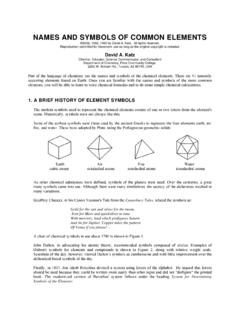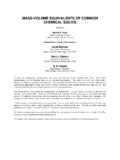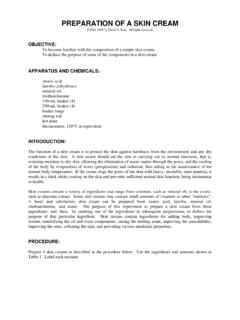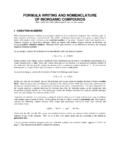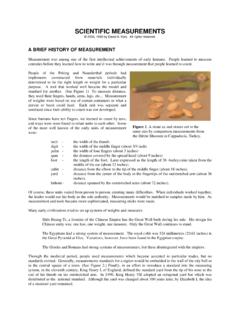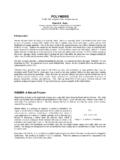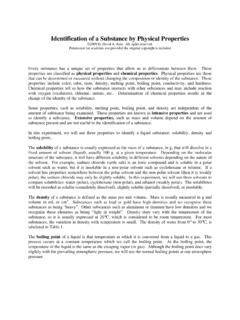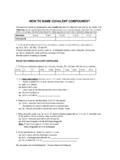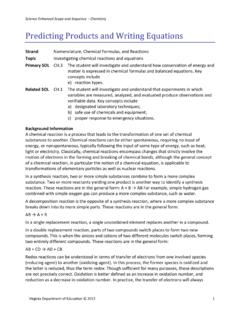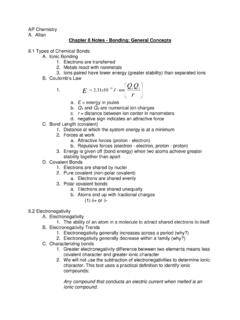Transcription of CHEMICAL FORMULAS AND FORMULA WEIGHT …
1 CHEMICAL FORMULAS AND FORMULA WEIGHT CALCULATIONS 1. THE MEANING OF A CHEMICAL FORMULA A CHEMICAL FORMULA is a shorthand method of representing the elements in a compound. The FORMULA shows the FORMULAS of the elements in the compound and the ratio of the elements to one another. For example, the forumla for sodium chloride: NaCl tells us that the compound is composed of the elements sodium, Na, and chlorine, Cl, in a one-to-one ratio. That is, one atom of sodium combines with one atom of chlorine. When elements combine in different ratios, subscripts are added, following the element symbol, to -indicate that the number of atoms of that element in the compound if it is greater than one. The subscript refers only to the element it immediately follows. For example, the FORMULA for magnesium bromide: MgBr2 tells us that two bromine atoms combine with one magnesium atom. Some elements form stable groups, or polyatomic ions, that combine with other elements to form compounds.
2 An example of this is the sulfate polyatomic ion in the compound calcium sulfate: CaSO4 In this compound, the SO4 is called a sulfate group. It consists of one sulfur atom combined with four oxygen atoms. The sulfate group cannot exist by itself and must be combined with another element. The compound CaSO4 consists of one calcium atom combined with one sulfate group. Counting atoms, calcium sulfate consists of one calcium atom, one sulfur atom, and four oxygen atoms. Another example of an atom combined with a polyatomic ion is barium nitrate: Ba(NO3)2 This compound consists of a barium atom combined with two nitrate groups. Since NO3 is readily identified as a nitrate group, and barium combines with two nitrates, parentheses are placed around the nitrate and the subscript 2 indicates two nitrate groups. Changing the subscripts in the nitrate to N2O6 would chang e the meaning of the FORMULA and is incorrect.
3 Counting atoms, barium nitrate consists of one barium atom, two nitrogen atoms, and six oxygen atoms. In the compound zinc phosphate: Zn3(PO4)2 we encounter another polyatomic ion, phosphate, PO4. In this example, three atoms of zinc combine with two phosphate groups. Counting atoms, there are three atoms of zinc, two atoms of phosphorus, and eight atoms of oxygen. The meaning of these FORMULAS are summarized in Figure 1. Reprinted from Katz, David A., The General Chemistry Survival Manual, 1990 by David A. Katz. All rights reserved. No part of this material may be reproduced in any form or by any means, electronic or mechanical, including photocopying, without permission in writing from the author. Figure 1. The meaning of some CHEMICAL FORMULAS . NaCl Symbol indicates the Symbol indicates the element sodium element chlorine No subscripts indicate only one atom of each element MgBr2 Symbol indicates the Subscript indicates two element magnesium atoms of bromine No subscript indicates Symbol indicates the only one atom of magnesium element bromine FORMULA indicates the sulfate polyatomic ion Symbol indicates the consisting of the elements element calcium sulfur and oxygen CaSO4 No subscript indicates Subscript indicates only one atom of calcium four atoms of oxygen in one sulfate group No subscript indicates one atom of sulfur in one sulfate group FORMULA indicates the nitrate polyatomic ion Symbol indicates the consisting
4 Of the elements element barium nitrogen and oxygen Ba(NO3)2 No subscript indicates Subscript indicates two only one atom of barium nitrate polyatomic ions No subscript indicates Subscript indicates one atom of nitrogen three atoms of oxygen in one nitrate group in one nitrate group FORMULA indicates the phosphate polyatomic ion Symbol indicates consisting of the elements the element zinc phosphorus and oxygen Zn3(PO4)2 Subscript indicates Subscript indicates two three atoms of zinc phosphate polyatomic ions No subscript indicates Subscript indicates one atom of phosphorus four atoms of oxygen in one phosphate group in one phosphate group 2. CALCULATING A FORMULA WEIGHT OR MOLECULAR WEIGHT The FORMULA WEIGHT of a substance (element or compound) is the sum of the atomic weights of all the atoms in the CHEMICAL FORMULA of the substance.
5 A molecular WEIGHT of a substance is the sum of all the atomic weights of all the atoms in a molecule of a molecular substance. The terms FORMULA WEIGHT and molecular WEIGHT are often used interchangeably, but FORMULA WEIGHT includes simple or empirical FORMULAS of compounds, as well as, molecular FORMULAS . To calculate the FORMULA WEIGHT or molecular WEIGHT of a compound, set up a table: 1. List the elements in the compound 2. Determine the number of atoms of each element in the compound 3. Look up the atomic WEIGHT of each element and place them in the appropriate column 4. Multiply the number of atoms times the atomic weights to get the total mass of each element 5. Add the total masses of all the elements. Examples: 1. Calculate the FORMULA WEIGHT of sodium chloride, NaCl. Answer: Set up a table listing the elements in the compound, the number of atoms of each element, and the atomic WEIGHT of each element. Elements in Number of atoms Atomic the compound of each element WEIGHT Na 1 Cl 1 Multiply the number of atoms times the atomic WEIGHT to get the total mass of each element.
6 Then add the total masses. Elements in Number of atoms Atomic Total the compound of each element WEIGHT Mass Na 1 x = Cl 1 x = FORMULA WEIGHT = Although there are no units of the atomic and FORMULA weights, the atomic weights are expressed in amu (atomic mass units) for single molecules or grams for laboratory quantities. 2. Calculate the FORMULA WEIGHT of magnesium bromide, MgBr2 Answer: Set up a table similar to the one used in example 1. Elements in Number of atoms Atomic Total the compound of each element WEIGHT Mass Mg 1 x = Br 2 x = FORMULA WEIGHT = 3.
7 Calculate the FORMULA WEIGHT of calcium sulfate, CaSO4 Answer: Elements in Number of atoms Atomic Total the compound of each element WEIGHT Mass Ca 1 x = S 1 x = O 4 x = FORMULA WEIGHT = 4. Calculate the FORMULA WEIGHT of barium nitrate, Ba(NO3)2 Answer: Elements in Number of atoms Atomic Total the compound of each element WEIGHT Mass Ba 1 x = N 2 x = O 6 x = FORMULA WEIGHT = 5. Calculate the FORMULA WEIGHT of zinc phosphate, Zn3(PO4)2 Answer: Elements in Number of atoms Atomic Total the compound of each element WEIGHT Mass Zn 3 x = P 2 x = O 8 x = FORMULA WEIGHT = Problems: Calculating FORMULA weights Calculate the FORMULA weights of the following compounds.
8 A) K2S2O4 b) Al2S3 c) Ag2CO3 d) Ca(C2H3O2)2 e) Cr2(SO4)3 f) H3PO4 g) Sn(OH)2 h) Ni2Fe(CN)6 i) Mg(IO3)2 j) Co(ClO4)2
